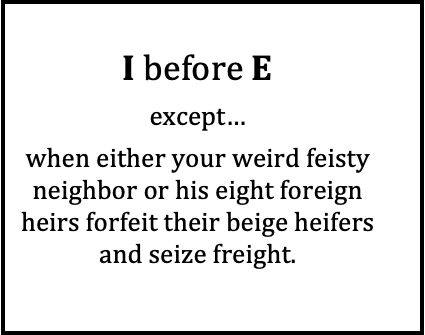Sound and Spelling Rules: How to handle the "ei" vowel pair
/I am sure you have seen posts like this before. I know I have, and I get a charge out of them. Whether or not you like to teach systematic phonics and spelling, you probably have a hard time getting kids to lock in certain sounds and spelling rules…and this one can be a doozy!
Let’s look at this dastardly duo up close. You have probably heard the old rule “I before E except after C?” Well, the rule doesn’t really end there. Nevertheless, this rule doesn’t always make spelling words that contain an “ei” vowel pair any easier. Let’s try it this way.
Teach a Sound Rule AND a Spelling Rule
1. Teach students that “ei” will sound like one of the following FOUR sounds in most English words, where an “ei” is found together in a word:
ē (Long E sound)
ā (Long A sound)
ĭ (Short I sound)
ī (Long I sound)
2. Teach words together that use both an “ei” or an “ie” in the middle and follow this simple rule:
Use ei after the letter C and to say /ā/; otherwise—use ie.
See how easy it is to spell these words right using this rule?
chief tie field beige niece heirs weird
We already see either an “ie” or an “ei” in each word, so all we have to do is look at the letter in front of each vowel pair to be able to get their order right. If there’s a C, it’s “ei”; if not, it has to be ie. Then, to pronounce the vowel pair correctly, use the four sounds we learned earlier:
ē (Long E sound) ā (Long A sound) ĭ (Short I sound) ī (Long I sound)
Yes, a few exceptions exist, but by getting more direct with the rules, the exceptions won’t present a major sound or spelling roadblock. In future posts, we’ll check out some other letter combos that give us fits. See you then!




































































































